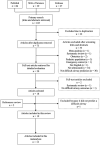Useful Ultrasonographic Parameters to Predict Difficult Laryngoscopy and Difficult Tracheal Intubation-A Systematic Review and Meta-Analysis
- PMID: 34124099
- PMCID: PMC8193063
- DOI: 10.3389/fmed.2021.671658
Useful Ultrasonographic Parameters to Predict Difficult Laryngoscopy and Difficult Tracheal Intubation-A Systematic Review and Meta-Analysis
Abstract
Unexpected difficult airway management can cause significant morbidity and mortality in patients admitted for elective procedures. Ultrasonography is a promising tool for perioperative airway assessment, nevertheless it is still unclear which sonographic parameters are useful predictors of difficult laryngoscopy and tracheal intubation. To determine the ultrasonographic predictors of a difficult airway that could be applied for routine practice, a systematic review and meta-analysis was conducted. Literature search was performed on PubMED, Web of Science and Embase using the selected keywords. Human primary studies, published in English with the use of ultrasonography to prediction of difficult laryngoscopy or tracheal intubation were included. A total of 19 articles (4,570 patients) were analyzed for the systematic review and 12 articles (1,141 patients) for the meta-analysis. Standardized mean differences between easy and difficult laryngoscopy groups were calculated and the parameter effect size quantified. A PRISMA methodology was used and the critical appraisal tool from Joanna Briggs Institute was applied. Twenty-six sonographic parameters were studied. The overall effect of the distance from skin to hyoid bone (p = 0.02); skin to epiglottis (p = 0.02); skin to the anterior commissure of vocal cords (p = 0.02), pre-epiglottis space to distance between epiglottis and midpoint between vocal cords (p = 0.01), hyomental distance in neutral (p < 0.0001), and extended (p = 0.0002) positions and ratio of hyomental distance in neutral to extended (p = 0.001) was significant. This study shows that hyomental distance in the neutral position is the most reliable parameter for pre-operative airway ultrasound assessment. The main limitations of the study are the small sample size, heterogeneity of studies, and absence of a standardized ultrasonographic evaluation method [Registered at International prospective register of systematic reviews (PROSPERO): number 167931].
Keywords: airway ultrasound assessment; prediction of difficult intubation; prediction of difficult laryngoscopy; ultrasound predictors of difficult intubation; ultrasound predictors of difficult laryngoscopy.
Copyright © 2021 Gomes, Simões, Nunes, Pereira, Teoh, Costa, Kristensen, Teixeira and Pêgo.
Conflict of interest statement
The authors declare that the research was conducted in the absence of any commercial or financial relationships that could be construed as a potential conflict of interest.
Figures












References
-
- Apfelbaum JL, Hagberg CA, Caplan RA, Blitt CD, Connis RT, Nickinovich DG, et al. . Practice guidelines for management of the difficult airway: an updated report by the american society of anesthesiologists task force on management of the difficult airway. Anesthesiology. (2013) 118:251–70. 10.1097/ALN.0b013e31827773b2 - DOI - PubMed
-
- Bajracharya G, Truong A, Truong D, Cata J. Ultrasound-assisted evaluation of the airway in clinical anesthesia practice: past, present and future. Int J Anesthesiol Pain Med. (2015) 1:1–10. http://anesthesia-painmedicine.imedpub.com/archive.php [accessed 12 June 2019]
-
- Crawley S, Dalton A. Predicting the difficult airway. BJA Educat. (2015) 15:253–57. 10.1093/bjaed/mku047 - DOI
-
- Shirgoska B, Netkovski J. Predicting difficult airway in apparently normal adult and pediatric patients. Pril. (2013) 34:155–9. - PubMed
Publication types
LinkOut - more resources
Full Text Sources
Medical

